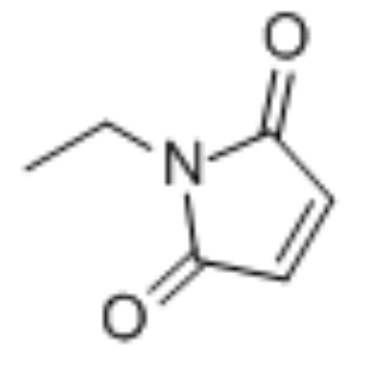N-ethylmaleimide

N-ethylmaleimide structure
|
Common Name | N-ethylmaleimide | ||
|---|---|---|---|---|
| CAS Number | 128-53-0 | Molecular Weight | 125.13 | |
| Density | 1.2±0.1 g/cm3 | Boiling Point | 210.0±9.0 °C at 760 mmHg | |
| Molecular Formula | C6H7NO2 | Melting Point | 43-46 °C(lit.) | |
| MSDS | Chinese USA | Flash Point | 73.3±0.0 °C | |
| Symbol |


GHS05, GHS06 |
Signal Word | Danger | |
|
RIPK3 regulates p62-LC3 complex formation via the caspase-8-dependent cleavage of p62.
Biochem. Biophys. Res. Commun. 456(1) , 298-304, (2014) RIPK3 is a key molecule for necroptosis, initially characterized by necrotic cell death morphology and the activation of autophagy. Cell death and autophagic signaling are believed to tightly regulate each other. However, the associated recruitment of signali... |
|
|
Extensive diversity of prion strains is defined by differential chaperone interactions and distinct amyloidogenic regions.
PLoS Genet. 10(5) , e1004337, (2014) Amyloidogenic proteins associated with a variety of unrelated diseases are typically capable of forming several distinct self-templating conformers. In prion diseases, these different structures, called prion strains (or variants), confer dramatic variation i... |
|
|
Disrupting SUMOylation enhances transcriptional function and ameliorates polyglutamine androgen receptor-mediated disease.
J. Clin. Invest. 125(2) , 831-45, (2015) Expansion of the polyglutamine (polyQ) tract within the androgen receptor (AR) causes neuromuscular degeneration in individuals with spinobulbar muscular atrophy (SBMA). PolyQ AR has diminished transcriptional function and exhibits ligand-dependent proteotoxi... |
|
|
Beclin 1 restrains tumorigenesis through Mcl-1 destabilization in an autophagy-independent reciprocal manner.
Nat. Commun. 5 , 5637, (2014) Mcl-1 is a unique Bcl-2 family member that plays crucial roles in apoptosis. Apoptosis-unrelated functions of Mcl-1 are however emerging, further justifying its tight regulation. Here we unravel a novel mechanism of Mcl-1 regulation mediated by the haplo-insu... |
|
|
The ubiquitin-selective chaperone Cdc48/p97 associates with Ubx3 to modulate monoubiquitylation of histone H2B.
Nucleic Acids Res. 42(17) , 10975-86, (2014) Cdc48/p97 is an evolutionary conserved ubiquitin-dependent chaperone involved in a broad array of cellular functions due to its ability to associate with multiple cofactors. Aside from its role in removing RNA polymerase II from chromatin after DNA damage, li... |
|
|
Chaperonin-containing TCP-1 complex directly binds to the cytoplasmic domain of the LOX-1 receptor.
FEBS Lett. 588(13) , 2133-40, (2014) Lectin-like oxidized low-density lipoprotein receptor (LOX-1) is a scavenger receptor that binds oxidized low-density lipoprotein (OxLDL) and has a role in atherosclerosis development. The N-terminus intracellular region (cytoplasmic domain) of LOX-1 mediates... |
|
|
Neddylation inhibits CtIP-mediated resection and regulates DNA double strand break repair pathway choice.
Nucleic Acids Res. 43(2) , 987-99, (2015) DNA double strand breaks are the most cytotoxic lesions that can occur on the DNA. They can be repaired by different mechanisms and optimal survival requires a tight control between them. Here we uncover protein deneddylation as a major controller of repair p... |
|
|
Cardiovascular disease-related parameters and oxidative stress in SHROB rats, a model for metabolic syndrome.
PLoS ONE 9(8) , e104637, (2014) SHROB rats have been suggested as a model for metabolic syndrome (MetS) as a situation prior to the onset of CVD or type-2 diabetes, but information on descriptive biochemical parameters for this model is limited. Here, we extensively evaluate parameters rela... |
|
|
Biotransformation and nitroglycerin-induced effects on antioxidative defense system in rat erythrocytes and reticulocytes.
Gen. Physiol. Biophys. 33(4) , 393-401, (2014) The effects of nitroglycerin (glyceryl trinitrate - GTN) are mediated by liberated nitric oxide (NO) and formed reactive nitrogen species, which induces oxidative stress during biotransformation in red blood cells (RBCs). The aim of this study was to evaluate... |
|
|
Dengue E Protein Domain III-Based DNA Immunisation Induces Strong Antibody Responses to All Four Viral Serotypes.
PLoS Negl. Trop. Dis. 9 , e0003947, (2015) Dengue virus (DENV) infection is a major emerging disease widely distributed throughout the tropical and subtropical regions of the world affecting several millions of people. Despite constants efforts, no specific treatment or effective vaccine is yet availa... |